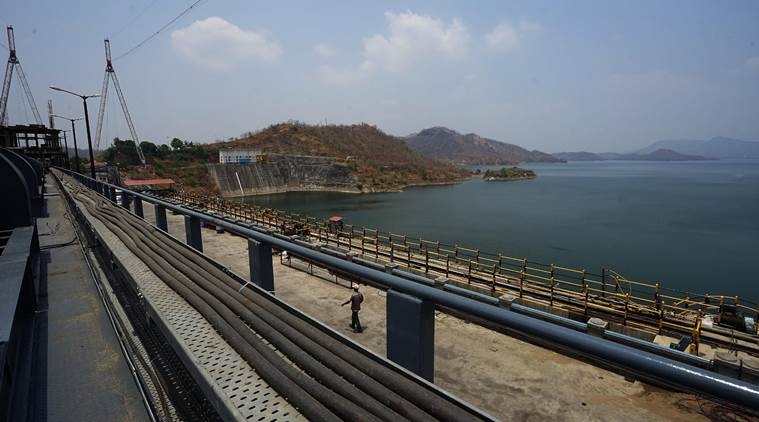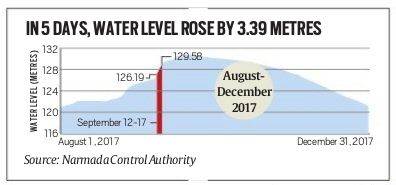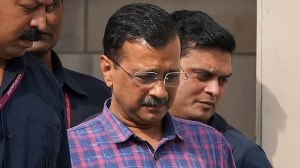- India
- International
Madhya Pradesh govt released surge of water for Narmada dam inauguration, then shut tap
Official records show the high level that day was achieved mainly because BJP-ruled Madhya Pradesh released an unusual amount of water from upstream dams over five days until the inauguration.
 Official records show the high level that day was achieved mainly because BJP-ruled Madhya Pradesh released an unusual amount of water from upstream dams over five days until the inauguration. (Express Photo/Bhupendra Rana/File)
Official records show the high level that day was achieved mainly because BJP-ruled Madhya Pradesh released an unusual amount of water from upstream dams over five days until the inauguration. (Express Photo/Bhupendra Rana/File)
On September 17, 2017, when Prime Minister Narendra Modi inaugurated the Sardar Sarovar Dam in Narmada district’s Kevadia, the water level in the reservoir was 129.58 m, just one metre short of the all-time high it has ever reached. It was seven weeks before the Gujarat elections.
Official records show the high level that day was achieved mainly because BJP-ruled Madhya Pradesh released an unusual amount of water from upstream dams over five days until the inauguration.
Also read | Gujarat in fix as Sardar Sarovar water level at alarming low
In fact, on three of those five days, records show, the rate of flow into the reservoir was five times the limit — “0.3 metres in 48 hours” for initial filling — set by the Central Water Commission (CWC), the apex water regulatory body.
The surge stopped the day of the ceremony (see charts).

While a former chairman of the CWC described the unprecedented release of water over those five days as optics for the inauguration ceremony, officials associated with the dam said it was part of a dam safety exercise and that the timing was just “a coincidence”.

Read | At Holy Triveni Sangam in Gujarat, ‘Narmada is almost dead’
Today, with Gujarat staring at a harsh summer, the state government has announced that it will stop supplying water from the dam for irrigation of crops from March 15. Now consider what official records of the Narmada Control Authority (NCA) show about the unusual surge in flow of water from September 12-17, 2017:
-Levels swelled by 3.39 m in those five days. In contrast, it took 28 days, from August 1-28, 2017, for the level to rise by about 2 m. It then took 15 days, from August 28-September 12, for the reservoir to swell by 3.24 m.
-The live storage of the reservoir gained 777 million cubic metres (MCM) of water. MP released 720.8 MCM in this period. Live storage is the portion of water that can be released for irrigation, and supply through power stations.
– On average, 19,31,400 litres per second flowed into the reservoir, as compared to an average of 3,63,300 litres per second the previous week — a nearly six-fold jump.
-The level began declining a week after, touching a peak of 130.75 metres on September 25— the full reservoir level (FRL) is 138.68 metres.

When contacted, a senior official of the Sardar Sarovar Narmada Nigam Limited (SSNNL) said the water was released for safety inspections — the first time since the gates were lowered on June 17, 2017.
“Dam safety inspections were necessary by maintaining reservoir levels as per Indian Standard Codal provisions for the first-time filling of the dam and as decided in the 51st meeting of the Sardar Sarovar Reservoir Regulation Committee held on June 27, 2017, in New Delhi,” said SSNNL’s general manager in-charge (tech and co-ord) A K Sharma.
“Therefore, Gujarat had requested to release its share of the utilisable water in the Narmada Basin so that testing could be undertaken,” he said in an emailed response. The spike is just a coincidence, said an official of the Narmada Control Authority (NCA), set up to monitor the sharing of Narmada water.
“The dam was filled in accordance with a filling schedule to conduct a dam safety exercise to check inundation levels,” said the official, who did not wish to be identified.
Despite repeated attempts by The Indian Express, Lal Singh Arya, MP Minister of State for Narmada Valley Development, were not available for comment. Rajneesh Vaish, vice chairman, Narmada Valley Development Corporation, declined comment.
In a statement Friday, Nitin Patel, Gujarat Deputy Chief Minister and in-charge of Narmada, acknowledged that the allocation of the river’s water to Gujarat is not linked with what is available in the Sardar Sarovar dam, but on the total available in the entire basin, particularly in MP.
“In the current year, due to installation of gates, the storage of water in Sardar Sarovar dam has increased. However, due to less rainfall, other dams of Madhya Pradesh, like Indirasagar, Bargi, Tava and other medium-size dams, have witnessed significant reduction of water storage… This makes it clear that our share of water depends on the storage of water by MP,” Patel said.
According to former CWC chief A K Bajaj, the release of water made it appear as if “they (authorities) wanted to show the Prime Minister that there was plenty of water in the reservoir”.
Referring to the spike, Bajaj said, “This clearly looks like an effort to increase water levels in the reservoir to FRL (138.68 metres) by a certain targeted date and since both state governments are under the same party, the MP government may have obliged Gujarat.”
The water level in the dam’s reservoir is dependent on two factors: upstream release from MP and rainfall in the intermediate catchment area.
Data show that MP and Gujarat registered deficit rainfall in August and September. The upper catchment area of the Narmada in western MP received 173.7 mm in August as against the monthly average of 308.7 mm. East Gujarat received 179.7 mm in August, against an average of 282.7 mm.
In September, western MP received 151.4, against the monthly average of 170.4 mm, and east Gujarat received 67.2 mm, as against the average of 160 mm. More specifically, in the week before the dam’s inauguration, there was heavy rainfall only on September 11, as measured as ‘spot rainfall’ in one upstream dam in MP, with light to moderate rainfall on some days in other locations.
The Sardar Sarovar Dam received an average of 5.32 mm as ‘spot rainfall’ between September 12-17, 2017. The dam is expected to irrigate 1.8 million hectares in Gujarat benefitting 1 million farmers with a canal network of approximately 75,000 km length within the state.
“The higher the water levels, more area between the sea and the canal level can be irrigated, benefitting more farmers across Gujarat. Compared to other rivers, the area of the main Narmada river is very limited. It is only the side branches and tributaries that can be used effectively for irrigation,” said G K Bhat, founder of Taru, an environmental consultancy based in Ahmedabad.
Read more from The Indian Express Series Narmada: Rationing the Lifeline
Must Read
Apr 23: Latest News
- 01
- 02
- 03
- 04
- 05






































